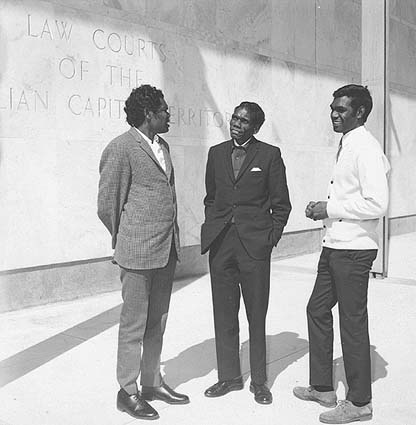
About Aboriginal Land
 |
|
| Left to right: Daymbalipu Munuŋgurr, Roy Dadayŋa
Marika and Galarrwuy Yunupiŋu outside
the court in Canberra during the Gove Peninsula land rights case,
September 1970. (National Archives of Australia A1200, L88863) |
"White people, we call them Balanda, have a different culture and we think they look at the environment in a different way. Balanda came to this place more than twenty years ago to mine bauxite and make money. Yolŋu here wanted to stop the mining and make Balanda [acknowledge] our right to control the land that was given to us by the Waŋarr [creator ancestors]. Our families took the mining company and the Australian Government to court. We wanted the Government to recognise that the land belonged to the Yolŋu. We told the Court stories about the Waŋarr and tried to explain our laws about land management. Permission was given by the elders to show the judge and lawyers some of our Madayin, our sacred objects. Yolŋu understand that Madayin are like title deeds. They give groups of people title to certain areas of land. The Balanda legal system did not accept this proof and we lost that court case." Nanikiya Munuŋgiritj[1]
Today, the Yolŋu Aboriginal people are the traditional owners of northeast Arnhem Land. The Aboriginal Land Rights (Northern Territory) Act of 1976 recognises Yolŋu as the owners of this land under Australian law.In 1971 Yolŋu lost the first Land Rights case in Australian history. However the case drew national attention to their cause. In 1972, the newly elected Labor government, under Gough Whitlam, initiated a judicial inquiry as the first move towards the legal recognition of Aboriginal rights in land. The resulting Northern Territory Land Rights Act was finally passed under the Liberal Government of Malcolm Fraser, in 1976. However the Act did not recognise Yolŋu ownership of areas of sea. (About Sea rights).
1. Munuŋgiritj, N., (1996) "Statement on the value of Biodiversity", Y'a'n, Number 7, May 1996, 4-6, Yirrkala Literature Production Centre.